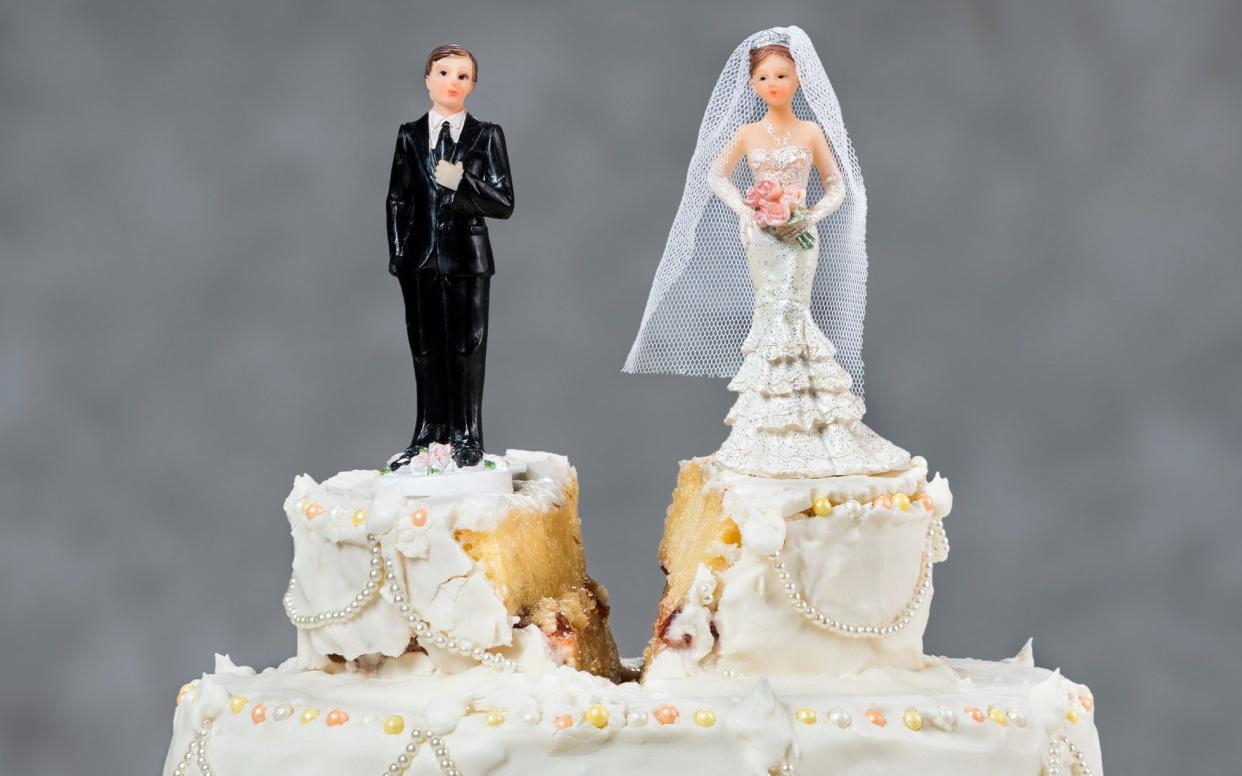Divorce rates fall to Seventies levels as women ‘happier in their marriages’

Divorce rates have dropped back to levels last seen in the 1970s because women are happier in their marriages, a report has claimed.
The study by the Marriage Foundation think tank found the current predicted risk of divorce over a lifetime for those marrying was 35 per cent – the same as it was for couples in the Seventies.
This figure is down almost 10 per cent from a 44 per cent peak in lifetime divorce levels among people who married in 1986, the group recorded as having the highest-ever rates of separations.
The paper found the decreasing rate of marriage breakdown had been “overwhelmingly” driven by a fall in the numbers of women filing for divorce.
In a long-term analysis of divorce rates, the researchers found that the numbers of divorces initiated by husbands had barely changed since the 1970s.
Official figures show divorces granted to wives have fallen 36 per cent from 109,883 in 1986 to 70,607 in 2021.
In contrast, the trend in men requesting a legal separation has remained largely stable, with a five per cent drop from 43,439 in 1986 to 41,327 in 2021.
Increased marital bliss
Explaining the decrease in wives pushing for divorces, Harry Benson, the research director for Marriage Foundation, said the reason for this change was that more women were content in their relationships.
Their increased marital happiness, he argued, was a result of having more committed husbands.
“Our research shows there are now fewer wives who are so unhappy with their husbands that they want to leave them,” Mr Benson said.
“This is about something men are doing to keep marital relations on a good footing because if it was due to other social factors such as marriage age or economic changes then you would see divorce rates fluctuate for those initiated by husbands and wives.
“The difference, I would argue, is that men are now showing greater levels of commitment.
“Traditionally there was a social pressure for couples to marry, which meant women were often marrying less committed men,” he added.
“But as marriage has become more optional, the men who marry genuinely want to do so rather than feeling obliged to and hence there are fewer divorces initiated by women.”
Divorce trends
The Marriage Foundation study found that of the 347,924 couples who married in 1986, 153,000 or 44 per cent either have or will divorce.
But most recently of 213,122 couples who married in 2019, just 74,000 (35 per cent) will be expected to or have separated.
Researchers based these findings on an analysis of divorce rates for each year from 1963 onwards.
They calculated a “predicted lifetime divorce rate” for the individual years based on the number of years of marriage and the current separation trends.
Mr Benson said the statistical method employed by the think tank is similar to the one used by the Office of National Statistics (ONS) to work out divorce trends.
He admitted that he could not be “completely sure” the predictions were correct for couples who married more recently, but said he could be confident that divorce rates will continue to slow in the way they have for previous year groups.
“Divorce rates overall rose for couples marrying in the 1960s, 70s and 80s and then fell for couples marrying in the 1990s, 2000s and 2010s,” the paper states.
Mr Benson also challenged the most recent figures released by the Office of National Statistics, which showed that divorce levels had spiked to an eight-year high following the Covid 19 pandemic.
Between 2020 and 2021 the number of married couples separating rose by 9.6 per cent from 103,592 to 113,505, the data reveals.
But Mr Benson suggests rather than the rise being an example of couples succumbing to the pressures of lockdown, it was likely to be due to a clearing of divorce backlogs and the faster processing of legal papers.
Poorer, not happier
However, some divorce experts have questioned the Marriage Foundation’s conclusion that fewer women are filing for divorce because they are happier with their husbands.
Sara Davison, a divorce coach who helps couples cope with relationship breakdowns, said: “Surely there are other reasons such as the financial cost of living crisis meaning that it is not financially or emotionally viable for women to leave.
“In my client experience women are often earning less and so in many cases it will be harder to make ends meet after divorce and I see the majority of childcare still falls to the women so this can make it harder to juggle commitments with work too.
“Combine this with the emotional rollercoaster and unavoidable divorce stress means that many women are opting to stay with their partners out of circumstance rather than happiness.”

